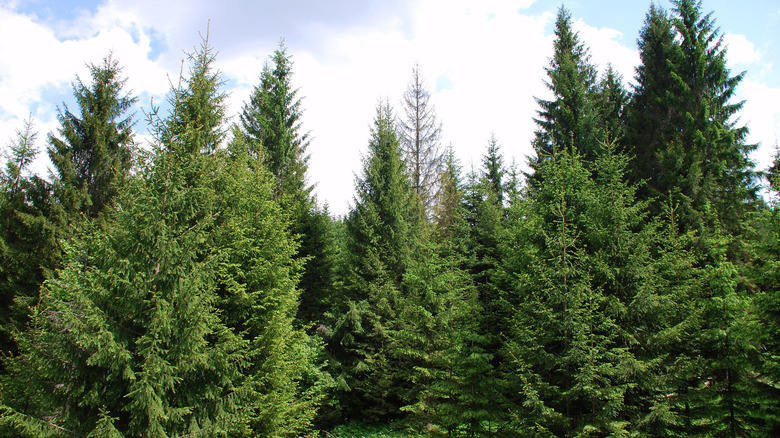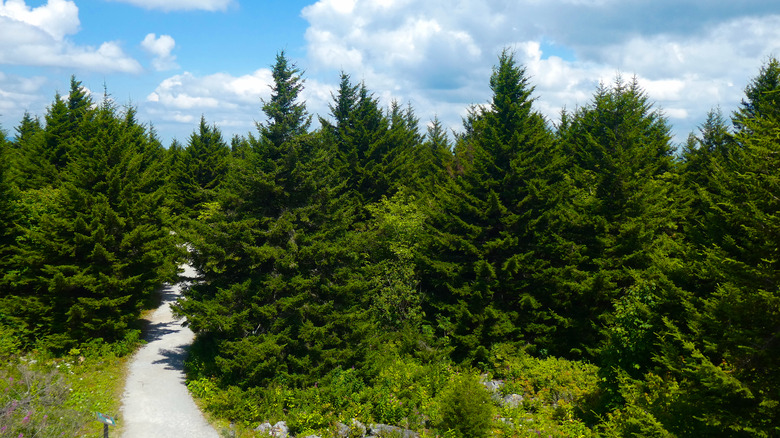The Fast-Growing Spruce Tree Variety You Should Avoid (& What To Plant Instead)
When you're refreshing your backyard landscape, you want to choose plants that grow quickly. While patience might be a virtue, no one wants to wait around for 10 years before their plans become reality. Watching saplings grow at a snail's pace takes the fun out of designing, since they'll leave giant gaps for years at a time. Because of this, you might turn towards planting fast-growing trees. However, one downside to this is that trees that shoot up in height quickly are usually invasive, which makes them dangerous to plant in your backyard. One such popular tree like this is the Norway spruce.
The Norway spruce is a popular pick in the northern United States because it can withstand the mean winters and hard frosts that come part and parcel with those regions. In fact, this attractive spruce can tolerate temps down to -40 degrees Fahrenheit without incurring damage, making them a safe bet in those garden designs. While it might be a convenient pick, you should skip including it in your landscaping if you live in certain states, due to its invasiveness. Here is what can happen if you decide to plant it on your property.
The Norway spruce is invasive
The Norway spruce is a bushy evergreen that will give your backyard a touch of hygge due to its Scandinavian Christmas tree aesthetic. Not only is it lovely to look at, but it's also extremely fast-growing. In fact, it's one of the fastest-growing spruces available, sprouting an average of 2 feet per year. It's also a deer-resistant tree, making it perfect for homes near woods, and it doubles as a natural partition, giving you privacy all year round. But while it might have loads of perks, if you live in certain states, you should avoid planting it because of its invasiveness. Specifically, it is invasive in Maryland, Tennessee, Hawaii, and North Carolina. While other states haven't declared it invasive, it's still a good idea to not plant it due to its aggressive growing style.
Its seeds get dispersed via the wind and can travel up to nearly 200 feet. It loves the shade, so you'll often see saplings growing underneath big trees. However, they frequently surpass those trees in height once they fully mature, and their thick canopies block out their sun, eventually killing them. Their canopies are what actually makes them so dangerous. Since they are extremely dense, it's very difficult for plants other than moss to grow underneath them, so the vegetation around them withers away. Because of this, it's best to skip the Norway spruce and plant another variety in your backyard.
What to plant instead
If you want a spruce tree in your backyard, you don't have to abandon your plans. Instead, choose a variety that isn't invasive. The best thing to do is to look up which spruce varieties are native to your area and plant those instead. For example, the Engelmann spruce is perfect for Pacific Northwest and Southwestern backyards. Just like the Norway spruce, it handles extreme weather conditions well, navigating temps as low as -50 degrees Fahrenheit and as high as 90 degrees Fahrenheit. However, the Eastern U.S. would be served well with the red spruce, which looks so similar to its Norway counterpart that they sometimes get mixed up.
For northern states, gravitate towards the white pine. Just like the Norway spruce, it proliferates very quickly, also growing 2 to 3 feet per year. You will get the exact same growth without the invasive repercussions. It even grows larger than its Norwegian counterpart, clocking in at a max of 98 feet, versus the Norway spruce's max of 60 feet. If you need a hardy evergreen that grows quickly, these non-invasive alternatives will fit the bill.


